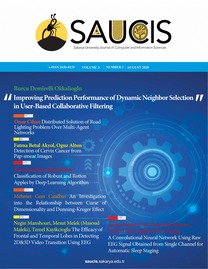A Hybrid Prognostic Approach Based on Deep Learning for the Degradation Prediction of Machinery
___
H. Zhang, Q. Zhang, S. Shao, T. Niu, and X. Yang, “Attention-Based LSTM Network for Rotatory Machine Remaining Useful Life Prediction,” IEEE Access, vol. 8, pp. 132188–132199, 2020, doi: 10.1109/ACCESS.2020.3010066.B. Wang, Y. Lei, N. Li, and W. Wang, “Multiscale Convolutional Attention Network for Predicting Remaining Useful Life of Machinery,” IEEE Trans. Ind. Electron., vol. 68, no. 8, pp. 7496–7504, Aug. 2021, doi: 10.1109/TIE.2020.3003649.
X. Li, Q. Ding, and J.-Q. Sun, “Remaining useful life estimation in prognostics using deep convolution neural networks,” Reliab. Eng. Syst. Saf., vol. 172, pp. 1–11, Apr. 2018, doi: 10.1016/j.ress.2017.11.021.
Z. Chen, M. Wu, R. Zhao, F. Guretno, R. Yan, and X. Li, “Machine Remaining Useful Life Prediction via an Attention-Based Deep Learning Approach,” IEEE Trans. Ind. Electron., vol. 68, no. 3, pp. 2521–2531, Mar. 2021, doi: 10.1109/TIE.2020.2972443.
M. Khazaee, A. Banakar, B. Ghobadian, M. A. Mirsalim, and S. Minaei, “Remaining useful life (RUL) prediction of internal combustion engine timing belt based on vibration signals and artificial neural network,” Neural Comput. Appl., Nov. 2020, doi: 10.1007/s00521-020-05520-3.
F.-K. Wang and T. Mamo, “Gradient boosted regression model for the degradation analysis of prismatic cells,” Comput. Ind. Eng., vol. 144, p. 106494, Jun. 2020, doi: 10.1016/j.cie.2020.106494.
Z. Xue, Y. Zhang, C. Cheng, and G. Ma, “Remaining useful life prediction of lithium-ion batteries with adaptive unscented kalman filter and optimized support vector regression,” Neurocomputing, vol. 376, pp. 95–102, Feb. 2020, doi: 10.1016/j.neucom.2019.09.074.
R. Wang and N. Chen, “Defect pattern recognition on wafers using convolutional neural networks,” Qual. Reliab. Eng. Int., vol. 36, no. 4, pp. 1245–1257, Jun. 2020, doi: 10.1002/qre.2627.
S. Xiang, Y. Qin, C. Zhu, Y. Wang, and H. Chen, “Long short-term memory neural network with weight amplification and its application into gear remaining useful life prediction,” Eng. Appl. Artif. Intell., vol. 91, p. 103587, May 2020, doi: 10.1016/j.engappai.2020.103587.
L. Ren, X. Cheng, X. Wang, J. Cui, and L. Zhang, “Multi-scale Dense Gate Recurrent Unit Networks for bearing remaining useful life prediction,” Futur. Gener. Comput. Syst., vol. 94, pp. 601–609, May 2019, doi: 10.1016/j.future.2018.12.009.
A. Al-Dulaimi, S. Zabihi, A. Asif, and A. Mohammadi, “A multimodal and hybrid deep neural network model for Remaining Useful Life estimation,” Comput. Ind., vol. 108, pp. 186–196, Jun. 2019, doi: 10.1016/j.compind.2019.02.004.
A. Khorram, M. Khalooei, and M. Rezghi, “End-to-end CNN + LSTM deep learning approach for bearing fault diagnosis,” Appl. Intell., vol. 51, no. 2, pp. 736–751, Feb. 2021, doi: 10.1007/s10489-020-01859-1.
Y. Chen, G. Peng, Z. Zhu, and S. Li, “A novel deep learning method based on attention mechanism for bearing remaining useful life prediction,” Appl. Soft Comput., vol. 86, p. 105919, Jan. 2020, doi: 10.1016/j.asoc.2019.105919.
B. Wang, Y. Lei, N. Li, and T. Yan, “Deep separable convolutional network for remaining useful life prediction of machinery,” Mech. Syst. Signal Process., vol. 134, p. 106330, Dec. 2019, doi: 10.1016/j.ymssp.2019.106330.
X. Li, X. Jia, Y. Wang, S. Yang, H. Zhao, and J. Lee, “Industrial Remaining Useful Life Prediction by Partial Observation Using Deep Learning With Supervised Attention,” IEEE/ASME Trans. Mechatronics, vol. 25, no. 5, pp. 2241–2251, Oct. 2020, doi: 10.1109/TMECH.2020.2992331.
H. Li, W. Zhao, Y. Zhang, and E. Zio, “Remaining useful life prediction using multi-scale deep convolutional neural network,” Appl. Soft Comput., vol. 89, p. 106113, Apr. 2020, doi: 10.1016/j.asoc.2020.106113.
M. Xia, X. Zheng, M. Imran, and M. Shoaib, “Data-driven prognosis method using hybrid deep recurrent neural network,” Appl. Soft Comput., vol. 93, p. 106351, Aug. 2020, doi: 10.1016/j.asoc.2020.106351.
Z. Yang, J. Zhang, Z. Zhao, Z. Zhai, and X. Chen, “Interpreting network knowledge with attention mechanism for bearing fault diagnosis,” Appl. Soft Comput., vol. 97, p. 106829, Dec. 2020, doi: 10.1016/j.asoc.2020.106829.
T. Xia, Y. Song, Y. Zheng, E. Pan, and L. Xi, “An ensemble framework based on convolutional bi-directional LSTM with multiple time windows for remaining useful life estimation,” Comput. Ind., vol. 115, p. 103182, Feb. 2020, doi: 10.1016/j.compind.2019.103182.
R. Shang, J. He, J. Wang, K. Xu, L. Jiao, and R. Stolkin, “Dense connection and depthwise separable convolution based CNN for polarimetric SAR image classification,” Knowledge-Based Syst., vol. 194, p. 105542, Apr. 2020, doi: 10.1016/j.knosys.2020.105542.
G. Huang, Y. Zhang, and J. Ou, “Transfer remaining useful life estimation of bearing using depth-wise separable convolution recurrent network,” Measurement, vol. 176, p. 109090, May 2021, doi: 10.1016/j.measurement.2021.109090.
A. Elsheikh, S. Yacout, and M.-S. Ouali, “Bidirectional handshaking LSTM for remaining useful life prediction,” Neurocomputing, vol. 323, pp. 148–156, Jan. 2019, doi: 10.1016/j.neucom.2018.09.076.
A. Saxena, K. Goebel, D. Simon, and N. Eklund, “Damage propagation modeling for aircraft engine run-to-failure simulation,” in 2008 International Conference on Prognostics and Health Management, Oct. 2008, pp. 1–9, doi: 10.1109/PHM.2008.4711414.
C. Zhang, P. Lim, A. K. Qin, and K. C. Tan, “Multiobjective Deep Belief Networks Ensemble for Remaining Useful Life Estimation in Prognostics,” IEEE Trans. Neural Networks Learn. Syst., vol. 28, no. 10, pp. 2306–2318, Oct. 2017, doi: 10.1109/TNNLS.2016.2582798.
G. Sateesh Babu, P. Zhao, and X.-L. Li, “Deep Convolutional Neural Network Based Regression Approach for Estimation of Remaining Useful Life,” in Lecture Notes in Computer Science (including subseries Lecture Notes in Artificial Intelligence and Lecture Notes in Bioinformatics), 2016, pp. 214–228.
- ISSN: 2636-8129
- Yayın Aralığı: Yılda 3 Sayı
- Başlangıç: 2018
Blockchain-Based Secure Credit Card Storage System for E-Commerce
Diagnosing Hematological Disorders Using Deep Learning Method
Tuba KARAGÜL, Nilüfer YURTAY, Birgül ÖNEÇ
A Hybrid Prognostic Approach Based on Deep Learning for the Degradation Prediction of Machinery
Base Station Power Optimization for Green Networks Using Reinforcement Learning
Deep Gated Recurrent Unit for Smartphone-Based Image Captioning
